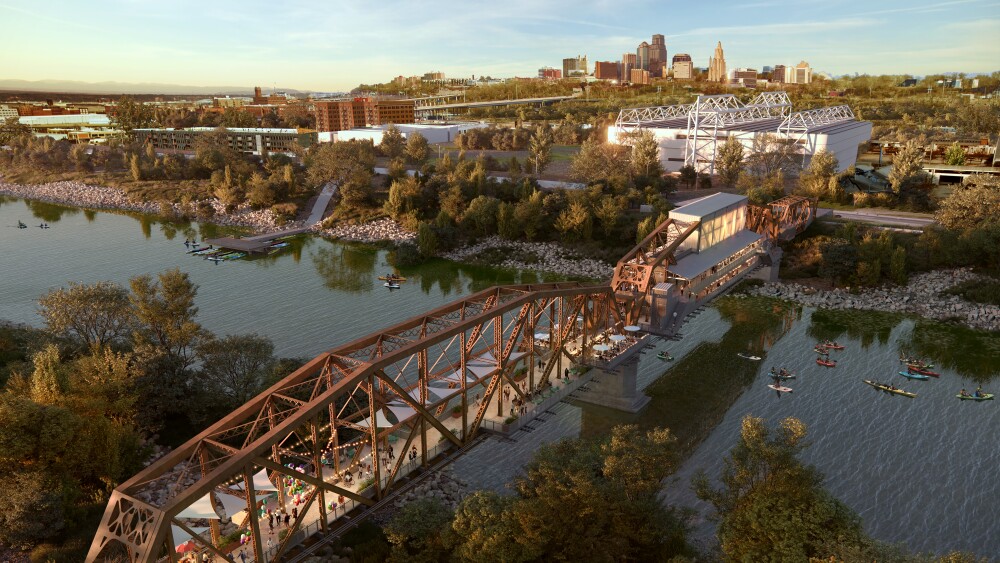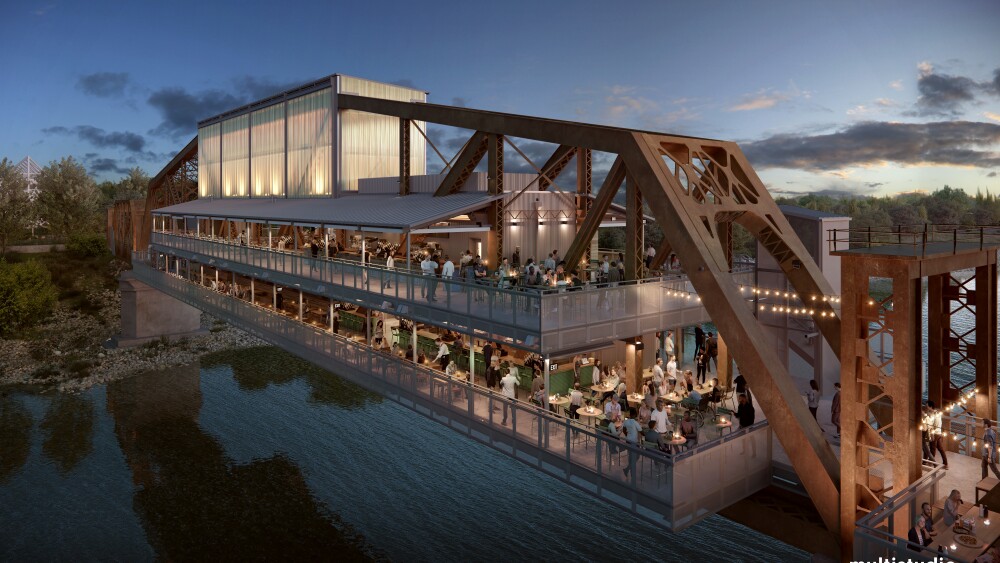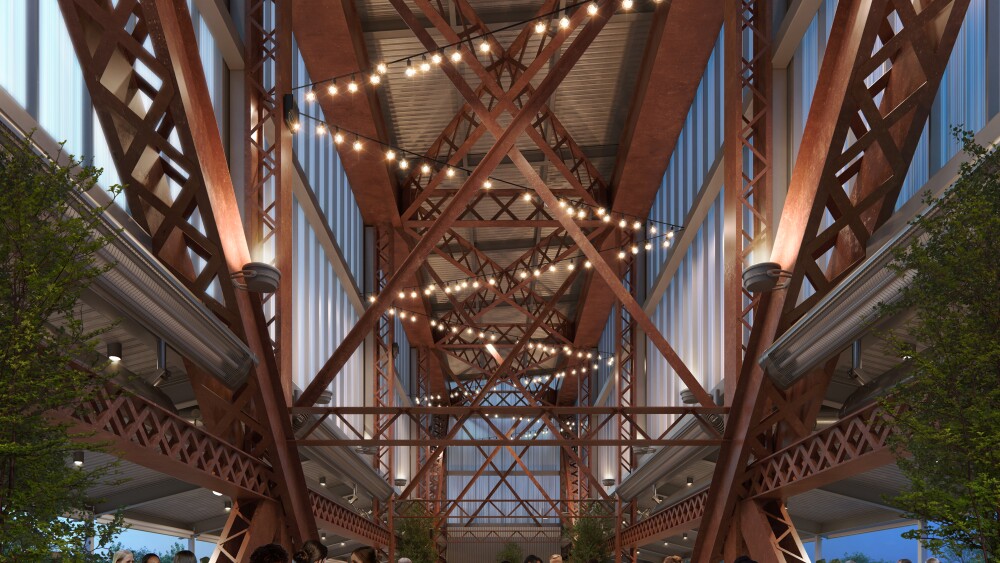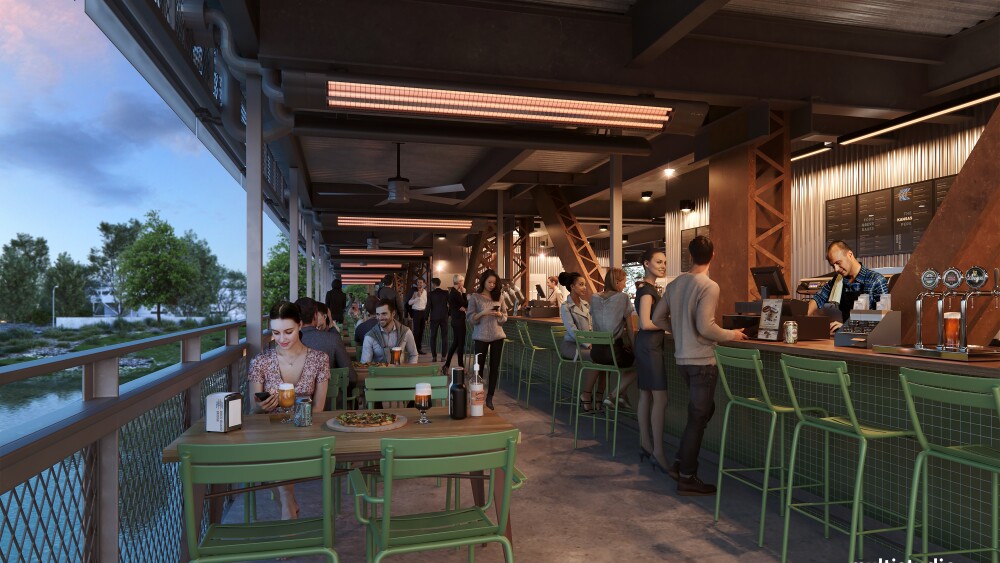Kansas City, once known for its livestock trade, has grown into a flourishing design center and boasts one of the fastest-growing economies in the Midwest. Its origin as a “cow town” to one deeply engaged with the built environment is evidence of the city’s resilience and adaptability.
In the late 1800s, the city’s primary industry was centered around the stockyards in Kansas City’s West Bottoms neighborhood. Spanning 200 acres, 170,000 animals were processed daily to be shipped to 42 states. Today, only a few remnants of this history remain, including the Rock Island Bridge.
Commissioned in 1905, the Rock Island Bridge was a vital part of the stockyard district’s railroad infrastructure. As the stockyards declined, the bridge eventually fell into disuse. By the 1980s, it had become a relic, left to rust with a forgotten past and an uncertain future. A common feature of cities throughout the country, the bridge embodied the dilemma of aging infrastructure from a bygone era—a relic of so little apparent value that it wasn’t worth the cost of demolition.
Anticipated to reach completion in the summer of 2024, the Rock Island Bridge is being reincarnated as an entertainment and dining destination, thoroughly reimagined and repurposed for the 21st century—and a showcase of how a city can put its industrial heritage back to use. This summer, the Rock Island Bridge will become the first in America to repurpose an abandoned bridge into a destination entertainment district. Its completion will hopefully inspire other cities to think about aging bridges and their respective waterfronts as places worthy of investment.
The revitalization began when Kansas City, Kansas, acquired the bridge from Kansas City, Missouri, in 2022, paving the way for a unique collaboration that has allowed the project to come to fruition. The developer, Michael Zeller of Flying Truss, worked alongside public, private, and philanthropic entities—a “4P” partnership between the city, private investors, and 19 philanthropic organizations. His vision and his ability to articulate it is a testament to entrepreneurship and faith in adaptive use. Zeller intends to take the concept to other cities across the U.S.
Spanning 700 feet across the Kansas River, the bridge links Kansas City, Missouri’s West Bottoms neighborhood at one end and Kansas City, Kansas’s Armourdale neighborhood at the other. Through its revitalization, the bridge has come to symbolize a new era for Kansas City’s riverfront—a convergence of culture, history, and community.
The Multistudio team’s primary goal was to connect the community to its history and river system, including a dynamic network of trails and parks, transforming how residents engage with their urban environment. In May 2023, the project was selected to join the High Line Network, a group recognizing infrastructure reuse projects dubbed the “next generation of public spaces.” These spaces aim to uplift communities by fostering vibrant gathering places, environmental resilience, equitable development, and economic growth.
Industrial aesthetic
The new design leans into a contemporary industrial aesthetic while preserving the monumental scale and experience of inhabiting the original truss structure. With structural engineering services provided by Thornton Tomasetti, construction made maximum use of existing materials and was finally completed using 386 tons of steel and 692 tons of concrete to effectively create a new real estate with broad cantilevers and an added second level.
As a trailhead for the Missouri and Kansas trail systems, the bridge invites foot traffic, bicyclists, and joggers. In addition to being a public trailway, it houses a multifunctional structure spanning two levels, each designed to enhance visitors’ experience. On the first floor, 14-foot cantilevers extend on either side, creating expansive spaces for vendors while allowing easy passthrough for those hiking the trail.
These overhangs host a variety of entertainment zones—including cafes, a bar, and dining areas—offering panoramic views of the river and the city skyline. Its programs foster an interplay between leisure and movement, allowing visitors to step off the trail, enjoy a refreshing drink, and immerse themselves in the scenery.
The second floor is a dedicated event venue strategically set apart and above the regular public traffic flow. This area features a vast event space complemented by an additional bar and is highlighted by a 35-foot atrium made from translucent polycarbonate. Natural light permeates the space and frames views of the bridge’s original trusses and structural details, blending historical architecture with modern design.
Adjacent to this event space, community zones on either side of the bridge offer retail opportunities for local farmers’ markets, small businesses, and nonprofits. These areas are vital in fostering community cohesion and integrating the levee trails with the waterfront, enhancing the bridge’s utility and allure as a central gathering point.
The confluence of the Missouri and Kansas rivers was the birthplace of Kansas City. Bridging those rivers established Kansas City as a commercial port for expansion, but the industry, railroads, and levees associated with the development of our rivers cut us off from our waterfronts. Now, the reinvented bridge promises to reconnect us in many ways, providing a brighter future for our two Kansas Cities.









